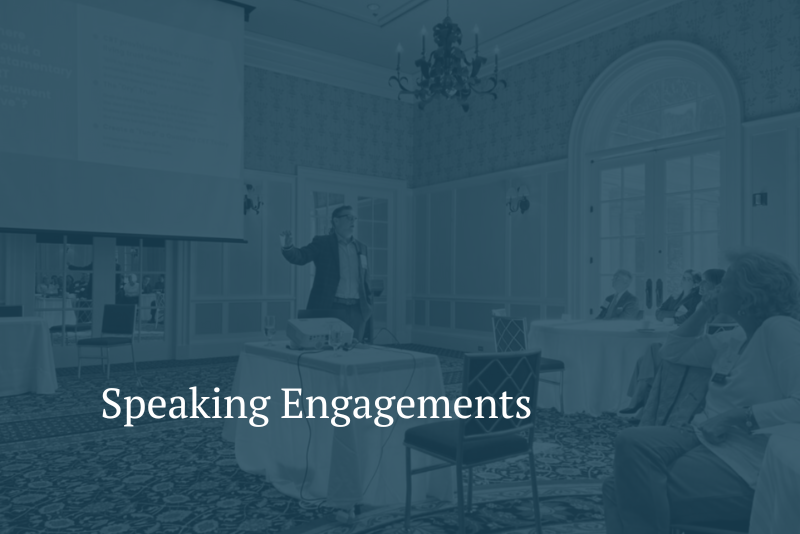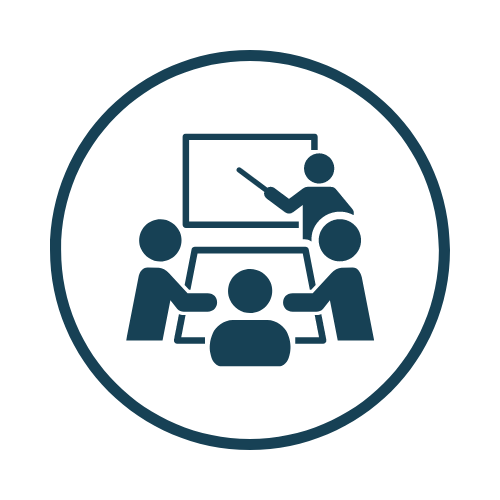
PGI’s President, Paul Caspersen, is available for public and private speaking engagements.

Interested in learning more about a specific planned giving topic?
Paul Caspersen, CFP®, AEP®, MS has been invited to share his knowledge and has delivered to many teams/organizations/groups over the past 25 years. Most recently, he has served as a board member for the National Association of Estate Planners and Councils (NAEPC) and has presented across the nation on various estate planning concepts.
FAQs
What audiences are best for your talks?
I frequently address professional advisors, nonprofits, staff, Boards, and donors/prospects, offering insights across a spectrum of interests.
For professional advisors, are some CE credits better than others?
Prioritize CLE for attorneys and CPE for accountants, due to their broad acceptance. While CFP and Insurance CE credits are available, they’re less of a draw. CFRE credits might be suitable for certain sessions aimed at specific learning objectives.
What is the right amount of CE credits and when is it best to have the session?
Two-hour sessions are preferred for their comprehensive coverage without being overly lengthy. While one-hour sessions might seem brief, longer sessions, including those up to four hours, are also available but might challenge attendee engagement.
What are your fees for engagements?
One-hour presentation: $999 plus travel expenses.
Half-day (3 hours): $2,999 plus travel expenses.
Full-day (6 hours): $4,999 plus travel expenses.
Virtual delivery options can be discussed for specific needs and times.
Do you require or provide a contract?
Formal contracts are not standard practice. Agreements detailing project scope, dates, and fees are typically confirmed via email, simplifying the process.
When do you bill for the event?
Invoices are sent 1-2 weeks following the event.
Are there any ways to lower the fees/expenses?
Collaborating with other hosts to split fees/expenses or scheduling multiple sessions in the same area can reduce costs. Sponsorships for specific events or the entire day are also an option.
BIO – Paul Caspersen
PHOTO – Paul Caspersen (headshot)


Paul presents regularly on the following topics:
Leveraging AI in Charitable Gift Planning for 2024 and Beyond
Description:
In this presentation, Paul Caspersen, CFP®, AEP®, MS will provide some updates in the dynamic evolution of AI in charitable gift planning since his last presentation with Bryan Clontz on this topic in April 2023. Participants will delve into a systematic 5-step process for analyzing charitable gifts, juxtaposed with the latest planned giving research tools. Caspersen will discuss best practices for incorporating AI and other technologies into technical planned giving research, and donor communication. Through compelling case studies, he will illustrate the successful integration of these technologies in the field. The session will be enriched by interactive dialogue, inviting audience contributions on their current use of AI in planned giving strategies. This presentation promises to furnish attendees with actionable insights.
The Charitable Planning Guide to the SECURE ACT (1.0 & 2.0)
Description:
The SECURE Act, both in its initial and subsequent iterations, has significantly altered the landscape of retirement and estate planning. This presentation, led by a seasoned expert in financial planning, will explore the intricacies of the SECURE Acts 1.0 and 2.0, with a particular focus on their implications for charitable planning. Attendees will gain a comprehensive understanding of the Acts’ key provisions, strategic planning opportunities they present for charitable giving, and how to navigate the potential challenges they pose. This session will equip participants with the knowledge to leverage these legislative changes in crafting effective charitable plans for their clients.
Top Three Ways to Use Life Insurance in Charitable Planning
Description:
Life insurance is a versatile tool in the realm of charitable planning, offering unique opportunities for philanthropic impact while also providing financial benefits. In this insightful presentation, participants will explore the top three strategies for incorporating life insurance into charitable giving plans. Covering a range of techniques from creating a lasting legacy to enhancing tax efficiency, this session will provide practical guidance and creative solutions for leveraging life insurance in charitable endeavors. Attendees will leave with actionable strategies that can be immediately applied to their charitable planning practices.
The ABC’s of CRTs
Description:
Charitable Remainder Trusts (CRTs) are a cornerstone of sophisticated charitable planning, blending philanthropic objectives with financial and tax planning benefits. This presentation will demystify CRTs, guiding attendees through their basic structure, operational mechanics, and the variety of ways they can be tailored to meet specific charitable and financial goals. Through detailed explanations and real-world examples, participants will learn how to effectively utilize CRTs in their planning, understanding both their benefits and their complexities. This session is ideal for professionals looking to deepen their expertise in advanced charitable planning techniques.
Creative Charitable Planning with Non-Cash Assets: A Case Study Approach
Description:
In the expansive field of charitable giving, non-cash assets remain a largely untapped reservoir of potential. With an estimated market value between $40 to $60 trillion, assets such as real estate, closely held stock, and collectibles account for a surprisingly small fraction of charitable contributions. This presentation, led by Bryan Clontz, dives deep into the world of non-cash asset charitable planning. Attendees will learn innovative strategies for leveraging real estate, privately held corporations, and other unique assets to maximize charitable impact and tax deductions for their clients. Through a series of detailed case studies, this session will not only illuminate the complexities involved but also equip participants with the practical skills needed to navigate this underexploited area of charitable planning.
Supporting Organizations: Imagine Donor Advised Funds on Steroids
Description:
Donor Advised Funds (DAFs) have become a popular tool for charitable giving, but Supporting Organizations offer a next-level approach with even greater flexibility and benefits. This presentation explores the concept of Supporting Organizations as DAFs “on steroids,” offering a comprehensive guide on how they operate, their advantages, and the strategic ways in which they can be utilized for philanthropy. Participants will gain insights into how Supporting Organizations can serve as powerful vehicles for sustained charitable impact, providing a deeper level of control and involvement in the distribution of funds. Ideal for donors and advisors alike, this session will open new horizons in philanthropic planning, encouraging a more dynamic approach to charitable giving.
Creative Charitable Gift Annuity Marketing Ideas
Description:
Charitable Gift Annuities (CGAs) represent an attractive option, offering both immediate tax advantages and lifelong income for donors. This timely presentation will introduce innovative marketing strategies for Charitable Gift Annuities, specifically designed to capture the attention of potential donors in the crucial year-end giving season. Attendees will learn how to effectively communicate the dual benefits of CGAs, engage with their audience through creative outreach, and implement strategic marketing campaigns. Whether you’re looking to boost your organization’s year-end fundraising efforts or advising clients on charitable giving, this session will provide valuable insights and fresh ideas to make the most of the giving season.
Direction Memo: The Importance of a Letter of Instructions in Modern Estate Planning
Description:
In the intricate process of estate planning, a Direction Memo or Letter of Instructions can serve as a vital communication tool, ensuring that one’s personal and philanthropic wishes are clearly understood and executed. This presentation will delve into the critical role that these documents play in modern estate planning, offering guidance on how to craft comprehensive and clear instructions. Attendees will learn best practices for creating effective Direction Memos, strategies for integrating charitable intentions, and how these documents complement formal legal instruments. By the end of this session, participants will possess the insights necessary to assist clients in articulating their legacy and charitable aspirations with clarity and confidence.

Interested in discussing further?
If you are interested in discussing further or would like to reserve a speaking engagement, please send us a note here.

© Planned Giving Interactive, LLC. All rights reserved.
